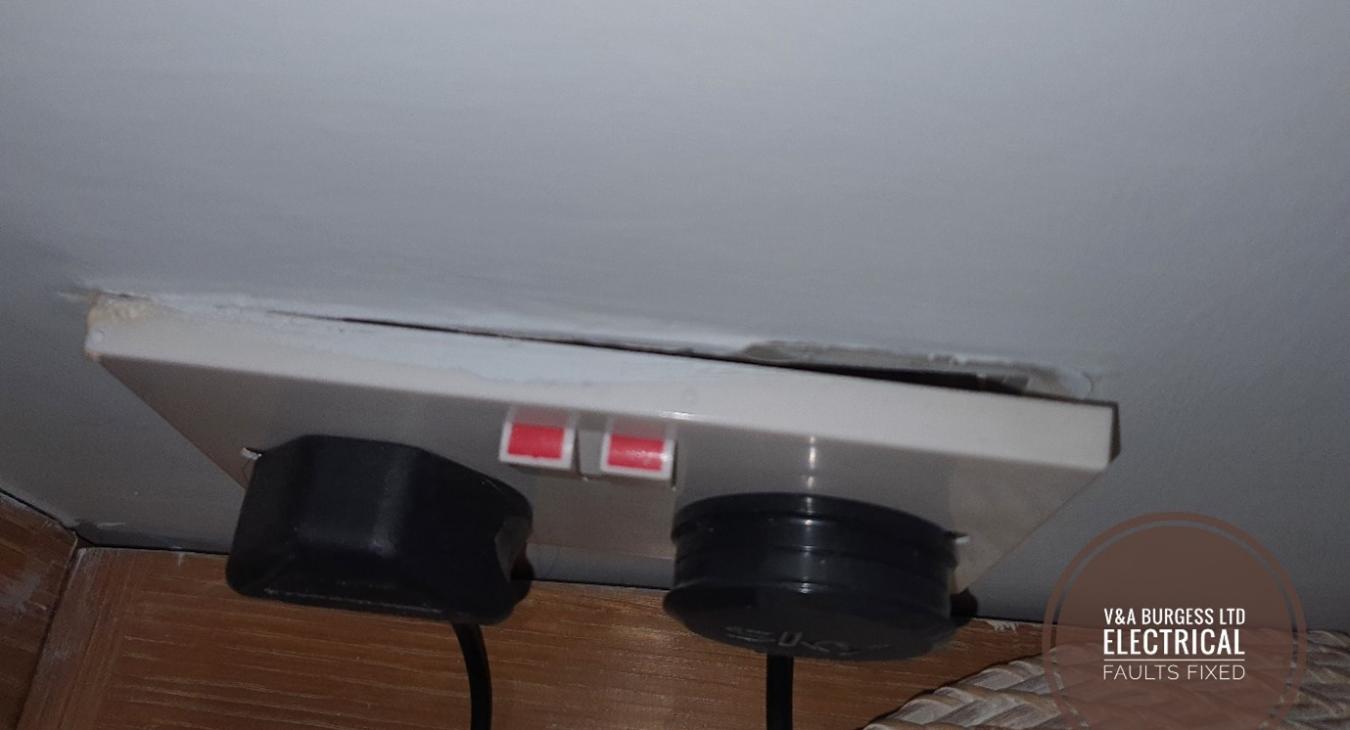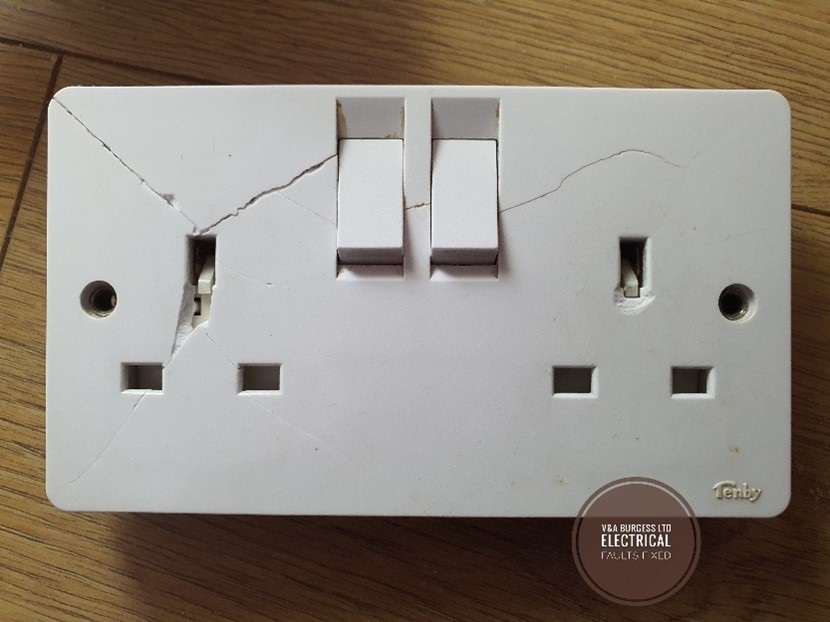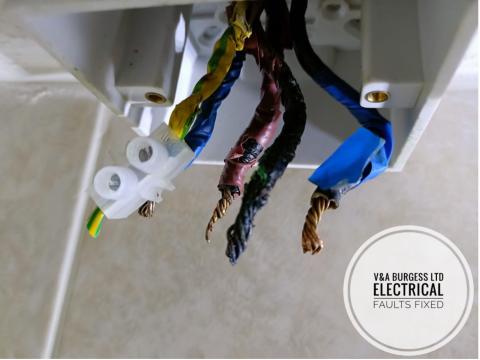
1) What is the Cause of Stiff Plug Sockets?
The photograph above is as a result of excessive forces applied to the stiff plug socket outlet. The result in cases like this is often loose outlets that come away from the wall and need to have other repairs carried out to ensure safety.
Our electrical outlets in our homes, and especially plug sockets, are subject to a range of wear and tear. With age and time comes corrosion, dirt and debris and damage. The likely cause of a stiff plug socket will be different in each set of circumstances.
There are a number of reasons why a PLUG SOCKET IS STIFF including:
- Brand new plug socket yet to be ‘worn in’
- Internal Damage to shutter mechanism
- Corrosion resulting in internal blockages
- Dirt and debris build up preventing full insertion
- Broken plug pin stuck in the plug socket
- A damaged or broken plug socket
2) Brand New plug socket?
If the plug socket in question is a brand new plug socket or, if your have purchased a new build home with several new plug sockets then this may be a completely benign issue. New sockets can take a while before the rocker switches and internal frictions loosen up slightly to allow the easy insertion and removal of plugs.
An electrical plug is designed to fit into the plug socket outlet rather snugly to allow good electrical contact between the socket internal contacts and the metal pins of the plug top itself. A new outlet is likely to feel rather stiff if you have been used to older plug sockets in an older home for example.
Solution: With no plugs inserted into the plug socket, try operating the rocker switch between the ‘on’ and ‘off’ position a few times and see if this helps loosen the switch mechanism a little. With the switch in the ‘’off’ position, try inserting and removing a plug several times and see if this helps to loosen things up a little.
Back to top3) Internal Damage to Shutter Mechanism
When damage occurs to the internal shutter mechanism the socket operation may become somewhat more difficult. If you find that the socket is overly stiff when inserting a plug then it may be the shutter mechanism is failing or has failed.
When a shutter mechanism has completely failed, it will often be impossible to insert a plug top partially or fully. This will regularly affect one side of a plug socket outlet or occasionally both.
Solution: Have the plug socket replaced by a professional electrician. Plug sockets cannot generally be repaired and must be replaced instead. Check the other plug sockets in your home for worn or damaged outlets and have those repaired at the same time to save costs and keep you safe.
Back to top4) Corrosion resulting in internal blockages
We can see from the photograph below that this plug socket outlet has become somewhat ruined by rust. Corrosion and rust will ruin electrical wiring, systems and electrical accessories like plug socket outlets fairly quickly.

Where rust has developed like this, the internal electrical contacts are also likely to be very corroded, rusted or otherwise offering a very poor electrical contact for plug tops that are inserted.
Solution: Solving the damp, condensation or water ingress problem is vital before replacing these accessories as the problem is likely to re-occur and may even damage electrical wiring causing expensive repairs.
Back to top5) Dirt and Debris
This is more of an issue with and old outlet rather than a new outlet but over time, dirt, debris, dust and other foreign particles can work their way into the internals of the plug socket causing high resistance for electricity flow, heating of the socket during operation and failure of the internals. This could result in a situation where a PLUG SOCKET IS STIFF.
Modern sockets do vary in quality and may not last as long as we expect them to. An older socket may be of very good quality but has fallen susceptible to its installed environment. A socket installed outside in a garage is likely to fail more quickly than one in a clean, dry home where it is seldom used.
Solution: Replace plug sockets that are installed in harsh environments, replace old plug sockets that are likely to be contaminated with dirt and debris. Attempting internal cleaning on a plug socket is dangerous and likely to result in electric shock, arcing and possible damage to the electrical system.
Back to top6) Broken Plug Pin stuck in the Plug Socket
With the influx of products from all over the world we are seeing variable quality in the manufacturing of appliances, electrical equipment and also plug tops! The plug top is not an expensive item to manufacturer with average costs around £2 or less for a new plug top. Some companies are nevertheless producing very cheap inferior plug tops where the earth pin commonly snaps off.
This earth pin is usually plastic and more prone to damage than a metal pin. The pin often remains in the plug socket once it has snapped off which is not only inconvenient for inserting other equipment but also a danger. The earth pin is responsible for opening the Line and Neutral Live terminals. When the earth pin is inserted, it operates the internal shutter mechanism to allow the remaining two pins on UK plugs to be inserted safely without giving rise to electric shock risk.
Solution: Turn all power off at the mains and attempt to remove the stuck pin from the socket, consult an electrician, if necessary, as plug socket replacement may be required.
Back to top7) Damaged or Broken Plug Socket
If your plug socket is damaged or broken visibly then there is a risk of electrical fires, electric shock and circuit breakers tripping or failing. In these circumstances, do a quick local search for electrical services and ask a qualified electrician to replace this for you as soon as possible.

If there is damage or something broken on the inside then it may not be immediately obvious as to the cause or the extent of the problem.
Solution: Regardless of any visible or hidden damage, if you suspect that your plug socket is faulty its best to have it replaced.
Back to top8) Summary
Regardless of the reason why a the PLUG SOCKET IS STIFF, we need to ensure that there is no damage. If there is damage internally then this can cause short circuits, high electrical resistances leading to excessive heat and other electrical problems.
There are a couple of things that you could try to alleviate the problem, however, in most cases it is nearly always best to have the plug socket replaced for a new one with no issues given the relatively low cost of this repair.
Back to top9) Common Questions
9.1) Is an overly tight outlet dangerous?
When electrical outlets are overly tight, it does not necessarily mean that they are a dangerous plug socket outlet. A wall outlet used for the first time can be somewhat resistant to the insertion of modern plugs.
9.2) Are loose outlets dangerous?
In older homes, we are more likely to experience loose plug socket outlets, plug tops that are loose in the outlets themselves and loose connections occurring at the rear of the electrical outlets.
Terminal screws can work loose at the back of plug sockets resulting in loose wires. Loose outlets can indeed be dangerous as there is the risk that live parts are exposed or the outlet may come away from the wall when a plug is inserted or removed.
Socket outlets that hold a plug in a loose fashion or feel loose when the plug is inserted are also likely to present some danger. Have your electrical outlets and wiring system checked every ten years or so by an electrician and a report obtained on its condition. This is the best form of home electrical system maintenance.
9.3) Is a loose fuse box dangerous?
A loose fuse box is indeed dangerous, all electrical equipment should be adequately secured so as not to present a danger. This is covered in great depth in the wiring regulations. Not only should the fuse box be secured correctly be an electrician but the wiring internally should be checked as ‘loose wires cause fires’.
Back to top









